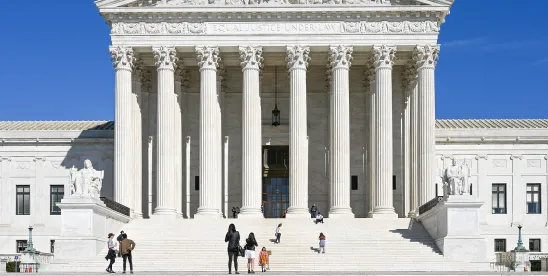In a trio of cases, the Supreme Court has changed the balance of power between courts and federal agencies. The combination of these three cases will likely lead to significant litigation in multiple courts, repeated re-litigation of issues (including previously settled issues), and potentially conflicting determinations across the country. For complex science and technical environmental matters, the Supreme Court’s decision will make it more difficult for the Environmental Protection Agency (EPA) to address environmental and public health matters, particularly for more ambitious regulations, or where the agency uses oldregulations to address new problems.
Chevron Deference is Over
Based on the language in recent Supreme Court cases, and the oral arguments in this case, it was no surprise that in Loper Bright v. Raimondo, No. 22-451, 603 U.S. ____ (2024), and Relentless v. Department of Commerce, No. 22-1219, 603 U.S. ___ (2024) (collectively, Loper), the Supreme Court overruled the long-established, 40 year old doctrine established. in Chevron v. Natural Resources Defense Council, 468 U.S. 1227 (1984), that where the language of a statute is silent or ambiguous, the federal courts will defer to a federal agency’s interpretation of the statute as long as the agency’s interpretation is reasonable. In a subsequent case, the Supreme Court had explained that Chevron deference arose from a presumption that Congress knew ambiguity in a statute would be resolved by the agency charged with implementing the statute. Smiley v. Citibank (South Dakota), 517 U.S. 735, 740-41 (1996). Until Loper, Chevron was cited in over 18,000 court opinions.
At issue in Loper was whether the National Marine Fisheries Service had the authority to require vessels to bear the cost of observers where the underlying statute required the presence of the observers but was silent on who paid for them. The Supreme Court majority focused on Section 706 of the Administrative Procedures Act (APA), which provides that a court “shall decide all relevant questions of law, interpret constitutional and statutory provisions, and determine the meaning or applicability of the terms of an agency action.” The majority concluded, “courts need not and under the APA may not defer to an agency interpretation of the law simply because a statute is ambiguous.” Putting a finer point on it, Chief Justice Roberts stated, “agencies have no special competence in resolving statutory ambiguities. Courts do.”
Challenges to Agency Rules are No Longer So Time-Barred
In Corner Post v. Board of Governors, No. 22-1008, 603 U.S. ____ (2024), the Supreme Court held that the six-year statute of limitations to challenge agency rules under the APA was triggered not by the issuance of the regulation, but from the date a party suffered injury as a result of the rule. Since Congress passed the APA in 1946, courts had operated under the general understanding of the statutory scheme that the APA’s six-year statute of limitations period begins to run upon publication of an agency rule.
Litigation challenging environmental rules has become routine in recent years, and the Corner Post decision has the potential to open up repeated challenges as new plaintiffs are aggrieved. In this case, the entity challenging the rule did not even exist at the time the rule was finalized. In herdissent in Corner Post, Justice Jackson tied this decision to the fall of Chevron deference and warned that the combination will cause a “tsunami of lawsuits” and will require that “[a]ny new objection to any old rule … be entertained and determined de novo by judges who can now apply their own unfettered judgment as to whether the rule should be voided.”
Agency Enforcement Actions to Assess Civil Penalties Can Now be Heard Directly in Court. Numerous federal agencies, including EPA, have the authority under federal statutes to enforce violations of federal law and assess civil penalties in administrative proceedings. In SEC v. Jarkesy, No. 22-859, 603 U.S. ___ (2024),the Supreme Court held for the first time, that when an administrative agency seeks civil penalties for claims that are based in the “common law,” the defendant has a right to a jury trial in a federal district court.
The Supreme Court embraced the history of the Seventh Amendment to the Constitution, which guarantees the right to trial by jury in civil cases, to conclude that the SEC administrative proceeding that assessed $300,000 for violations of the “antifraud provisions” of the Dodd-Frank Act was unconstitutional because it deprived Mr. Jarkesy of his right to a jury trial. In her dissent in Jarkesy, Justice Sotomayor suggested that “the Constitutionality of hundreds of statutes may now be in peril, and dozens of agencies could be stripped of their power to enforce laws enacted by Congress.”
This case may be particularly relevant in the environmental context, where many statutes have a common law origin. Defendants may still have the ability to waive a jury trial and proceed in an administrative context, but others may want to proceed before a jury in a court where the agency may not be given deference.
The Impact of the Supreme Court Decisions
Taken together, these three cases will lead directly to more litigation. There will be more litigation challenging federal agency regulations, and new challenges to old regulations where challenges were already resolved decades ago.
Without deference to an agency, multiple courts may reach conflicting decisions across the country that address the same regulations. Agencies will also have to take more enforcement actions to court and try their cases in front of juries.
Loper and Chevron address agency action that interprets a statute; these cases do not impact the Supreme Court’s decision in Auer v. Robbins, 117 S.Ct. 905 (1997) which held that an agency’s interpretations of its own regulations should be upheld unless it is “plainly erroneous or inconsistent with the regulation.” However, these decisions may also forecast the end to Auer; the Supreme Court has already chipped away at this doctrine in recent years, and given an appropriate case, the court might similarly put an end to this doctrine.
It is also worth viewing Loper in the context of the Supreme Court’s recent invocation of the “major questions doctrine,” which states that courts may review regulatory interpretations that have “vast economic and political significance.” West Virginia v. EPA, 597 U.S. 697 (2022). Those questions can now be evaluated by the courts with no deference to agencies and their experts.
All of this litigation will create a less certain regulatory environment for the regulated community, particularly in the environmental field.






 />i
/>i
